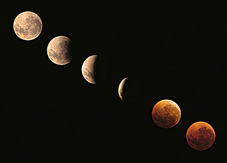The name "Babylon" has to be one of the most evocative from history, but what was the city really like?
Next week an exhibition is opening at the British Museum in London, that aims to bring this ancient city back to life again. It's called Babylon: Myth and Reality, and it runs from 13 November to 15 March. The real Babylon, according to the exhibition overview, was "an imperial capital, a great centre of science, art and commerce".
Events like this are often frustrating because although they are full of beautiful art exhibits, the science and technology of ancient cultures is under-represented. At the same time, museums that specialise in science and tech don't tend to have much to say about the ancient world.
Babylonian priests were among the most accomplished astronomers of their time. They believed that the movements of the Sun, Moon and planets were omens (generally bad ones) about the fate of the King and his country. Lunar and solar eclipses were especially significant. Here's a sample prediction from a list of omens called Enuma Anu Enlil: "When in the month Ajaru, during the evening watch, the moon eclipses, the king will die. The sons of the king will vie for the throne of their father, but will not sit on it."
Generations of priests watched the skies round the clock, and noted down everything they saw on clay tablets, so that the appropriate rituals could be carried out to avert whatever bad thing was going to happen. If an eclipse was predicted, for example, the king could abdicate temporarily, and grab a beggar off the street to sit on the throne in his place until the eclipse had passed.

A lunar eclipse Luc Viatour
By the sixth century BC, the Babylonians could recognise regular cycles in the movements of celestial bodies. They didn't have any sense of geometrical orbits - events in the sky might as well have been a light show taking place on a flat screen - but they could use arithmetical methods to predict in advance what was going to happen. They knew that the Sun and Moon's relative motions repeat after 19 years for example (because there are almost exactly 235 lunar months in 19 solar years) and that eclipses repeat after an 18-year cycle.
Intriguingly, both of these cycles are found in the Antikythera mechanism, showing that Greek astronomers were heavily influenced by the Babylonians at the time. The eclipse data may have been brought back to Greece by an astronomer called Hipparchus, who worked on Rhodes in the second century BC. He had lists of Babylonian observations going back centuries - one theory is that he must have visited Babylon himself, and worked with a scribe there to extract the data he needed.
By this time, Babylon (in what is now southern Iraq) was an empty city. Alexander the Great had taken over the region in the fourth century BC, and his successor Seleucus moved all the inhabitants to a new capital, Seleucus (of course) on the river Tigris. But a small band of priests had refused to leave and were still there in Hipparchus's time, observing the skies and carrying out their rituals in the empty temple.
I asked the British Museum if any of this would be represented in the exhibition and although the Babylonians' interest in astronomy will be mentioned, there won't be any related exhibits. There is an associated website for schools, however, which includes a section on Babylonian astronomy (among other things you can explore a mini-library of carved tablets, along with their astronomical translations). And John Steele of Durham University, who probably knows more about ancient eclipse prediction than anyone, is giving a talk about Babylonian astronomy and astrology at the museum on December 4.